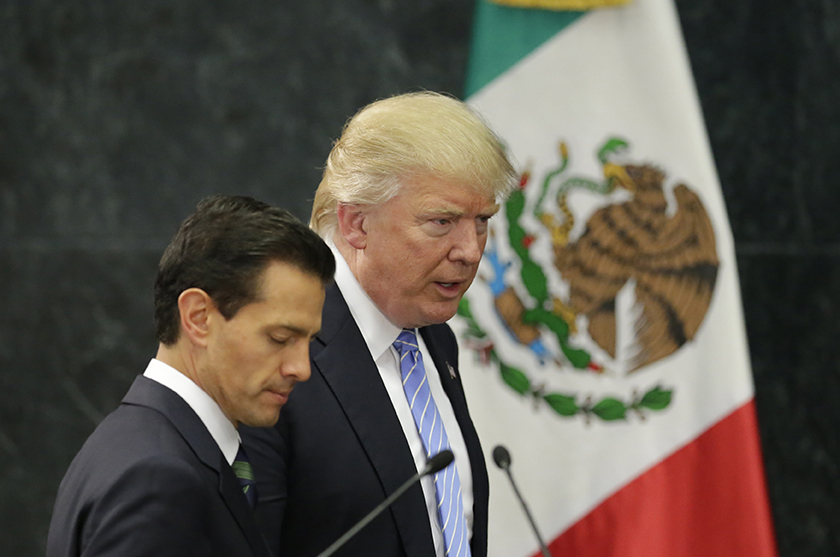 Peter Schechter, senior vice president for strategic initiatives and director, Adrienne Arsht Latin America Center
Peter Schechter, senior vice president for strategic initiatives and director, Adrienne Arsht Latin America Center
Important progress was made during the Obama administration to advance US interests in the Western Hemisphere. First impressions are frequently wrong. But Donald Trump’s rhetoric targeting Hispanics—specifically Mexicans—throughout the campaign raises concerns that progress could be halted. Here are a few thoughts to keep in mind as President-elect Trump chooses his top cabinet officials and sets international policy priorities:
1. Latin America seems determined to open its economies and engage with the world at the very moment that the United States and Europe seem determined to close borders and restrict trade. The election of Mauricio Macri in Argentina, Pedro Pablo Kuczynski in Peru, and the accession of Michel Temer in Brazil are demonstrative of this outward-oriented political shift.
2. Mexico remains the United States’ second-largest export destination and, with 2,000 miles of shared border, an important security partner. Despite campaign rhetoric, free-trade agreements are not easily undone, and NAFTA has many positive economic benefits. Updating a twenty-five-year agreement is a perfectly sensible demand. But the new president may insist on a full renegotiation of NAFTA, as well as undoing US President Barack Obama’s executive order protecting undocumented youth and parents of US citizens from deportation. Such actions would ratchet up tensions on our southern border.
3. Colombia’s achievements on the economic and security fronts are a fifteen-year bipartisan US foreign policy success story. So far, the United States has supported the government’s peace initiative, led by President Juan Manuel Santos. But Trump may well feel much more at home with former President Alvaro Uribe’s hardline definition of the Revolutionary Armed Forces of Colombia (FARC) as a criminal group that deserves jail time, rather than political recognition. This could result in the reconsideration of the additional $100 million that Obama promised in support of “Peace Colombia” and could strain the bipartisan consensus behind US support for Colombia.
4. Polls show Obama’s diplomatic opening to Cuba is popular in every age group, every region, and crosses party lines. While chances are low that America’s new president will again break diplomatic relations with Havana, many of the sanctions-loosening travel, trade, and exchange regulations recently promulgated by the US Departments of Treasury and Commerce could be reversed.
Jason Marczak, director, Latin America Economic Growth Initiative
Donald Trump’s campaign tapped into deep anxiety among US workers about how the world is changing and their concern that they are being left behind. Predictions that Latinos would flat out reject his candidacy proved to be wrong. Why? The 29 percent who voted for him (two percentage points more than Republican nominee Mitt Romney got four years ago) saw Trump as the messenger for their frustrations. The spike in anti-immigrant/anti-Mexico rhetoric did not drive Latinos away from Trump. They want the change he promised.
What does Trump’s election mean for Latin America? A Trump administration will double-down on shoring up its domestic agenda. That’s what propelled Trump to victory. Yet foreign policy hotspots will get presidential attention.
Issues such as Central America’s Northern Triangle (Guatemala, El Salvador, and Honduras) and Cuba made their way into cabinet meetings during the Obama administration. With the notable exception of Mexico, policy toward Latin America will not be a priority in a Trump administration. As a result, the policymaking process will largely be confined to Foggy Bottom, and even there, to the Western Hemisphere department.
For countries like Brazil, where the relationship with the United States is largely based on technical-level working groups, not much is likely to change. But Argentina, where US President Barack Obama traveled in the spring to mark a dramatic turnaround in relations from that with the previous administration in Buenos Aires, is unlikely to see much attention paid to it from the Trump administration.
The big exception here is Mexico. Trump will soon be faced with the difficult task of separating campaign rhetoric from reality. Yes, he will further clamp down on border security and seek to build a wall. And yes, he will try to renegotiate parts of NAFTA. But if a deal cannot be made, he will have to weigh the consequences of blunt action with the economic ramifications it would bring. For example, pulling out of NAFTA—as detailed in the soon-to-be-famous Article 2205—would cause great job loss in the United States for millions of workers who may not even realize that their jobs depend on this deep supply chain. It would also throw the Mexican economy in a tailspin, pushing more people to cross the US border—either under a potential border-wide wall or around it—in search of opportunity.
Countries like Argentina, Brazil, and Peru all have new outward-looking presidents who understand that growth is dependent on broader global engagement—a shift from the inward-focused perspective taken by many Latin American countries over the years. Now the tables have turned and it’s the incoming US administration that sees protectionism as the way to build the economy. Hopefully, the lessons of Latin America will resonate in the United States.
Image: Donald Trump met Mexican President Enrique Peña Nieto in Mexico City on August 31. As the next president of the United States, Trump is expected to focus his attention on Mexico. (Reuters/Henry Romero)

